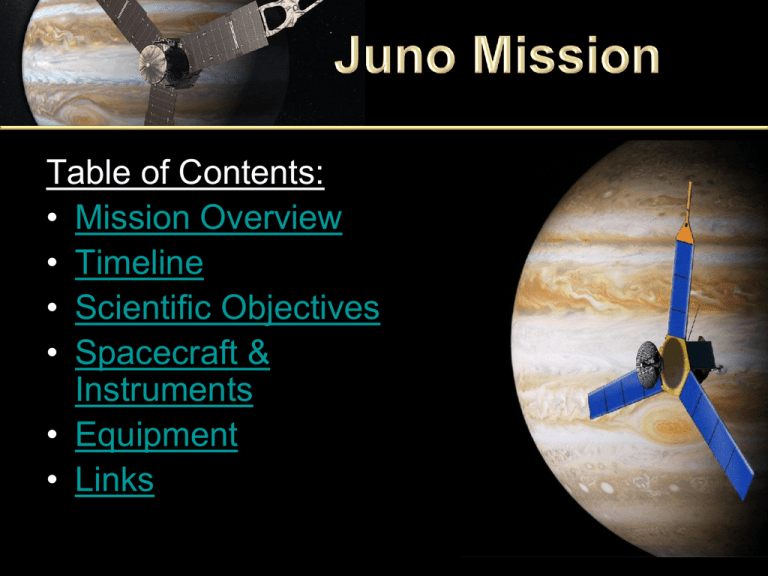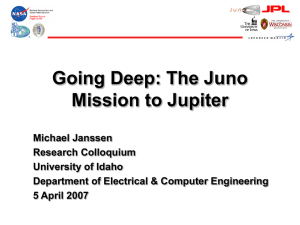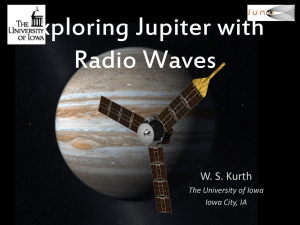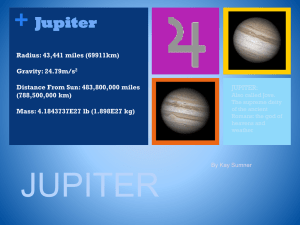Juno
advertisement

Table of Contents: • Mission Overview • Timeline • Scientific Objectives • Spacecraft & Instruments • Equipment • Links MISSION OVERVIEW Juno’s principal goal is to understand the origin and evolution of Jupiter. Underneath its dense cloud cover, Jupiter safeguards secrets to the fundamental processes and conditions that governed our solar system during its formation. As our primary example of a giant planet, Jupiter can also provide critical knowledge for understanding the planetary systems being discovered around other stars. Back to Table of Contents MISSION OVERVIEW The Juno spacecraft will investigate Jupiter's origins, its interior structure, its deep atmosphere and its magnetosphere from an innovative, highly elliptical orbit with a suite of seven science instruments. In addition, a camera called JunoCam will be used by student participants in the Juno Education and Public Outreach program to take the first images of Jupiter's polar regions. Back to Table of Contents TIMELINE • August 5, 2011: Juno spacecraft launches • October 9, 2013: Earth flyby gravity assist • July 5, 2016: Juno spacecraft arrives at Jupiter • Oct 2017: Juno will end operations. Back to Table of Contents SCIENTIFIC OBJECTIVES Origin – Jupiter’s solid core and abundance of heavy metals in the atmosphere make it an ideal model to understand the origin of giant planets. Juno will measure global abundances of oxygen and nitrogen by mapping the gravitational field and using microwave observations of water and ammonia. Interior – Juno will map Jupiter’s gravitation and magnetic fields, revealing the interior structure, the origin of the magnetic field, the mass of its core, the nature of deep convection, and the abundance of water. SCIENTIFIC OBJECTIVES Atmosphere – Jupiter has the most massive atmosphere of all the planets. By mapping variations in atmospheric composition, temperature, cloud opacity and dynamics, Juno will determine the global structure and dynamics of Jupiter’s atmosphere below the cloud tops for the first time. Magnetosphere – Jupiter’s powerful magnetospheric dynamics create the brightest aurora in our solar system. Juno will measure the distribution of the charged particles, their associated fields, and the concurrent UV emissions of the planet’s polar magnetosphere, greatly improving our Back to Table of Contents understanding of this remarkable phenomena. SPACECRAFT For Juno, like NASA’s earlier Pioneer spacecraft, spinning makes the spacecraft's pointing extremely stable and easy to control. Just after launch, and before its solar arrays are deployed, Juno will be spun-up by rocket motors on its still attached second-stage rocket booster. While in orbit at Jupiter, the spinning spacecraft sweeps the fields of view of its instruments through space once for each rotation. At three rotations per minute, the instruments' fields of view sweep across Jupiter about 400 times in the two hours it takes to fly from pole to pole. SPACECRAFT Jupiter’s orbit is five times farther from the Sun than Earth’s, so the giant planet receives 25 times less sunlight than Earth. Juno will be the first solar-powered spacecraft designed to operate at such a great distance from the sun. Three solar panels extend outward from Juno’s hexagonal body, giving the overall spacecraft a span of more than 66 feet (20 meters). The solar panels will remain in sunlight continuously from launch through end of mission, except for a few minutes during the Earth flyby. Back to Table of Contents SPACECRAFT Jupiter’s orbit is five times farther from the Sun than Earth’s, so the giant planet receives 25 times less sunlight than Earth. Juno will be the first solar-powered spacecraft designed to operate at such a great distance from the sun. Three solar panels extend outward from Juno’s hexagonal body, giving the overall spacecraft a span of more than 66 feet (20 meters). The solar panels will remain in sunlight continuously from launch through end of mission, except for a few minutes during the Earth flyby. Back to Table of Contents SPACECRAFT Juno will avoid Jupiter's highest radiation regions by approaching over the north, dropping to an altitude below the planet's radiation belts – which are analogous to Earth’s Van Allen belts, but far more deadly – and then exiting over the south. To protect sensitive spacecraft electronics, Juno will carry the first radiation shielded electronics vault, a critical feature for enabling sustained exploration in such a heavy radiation environment. Back to Table of Contents Spacecraft Instruments • • • • • • • • • Magnetometer Microwave Radiometer Plasma Waves Instrument Jovian Infrared Auroral Mapper JunoCam Ultraviolet Spectrograph JEDI Jade Gravity Science Back to Table of Contents Magnetometer/Advanced Stellar Compass The magnetic field investigation has three goals: mapping of the magnetic field, determining the dynamics of Jupiter's interior, and determination of the three-dimensional structure of the polar magnetosphere. To achieve these goals, the mission employs a Flux Gate Magnetometer and an Advanced Stellar Compass (ASC) to provide accurate pointing information of the Juno spacecraft for precise mapping. Back to Equipment Index Microwave Radiometer The primary goal of the Juno Microwave Radiometer is to probe the deep atmosphere of Jupiter at radio wavelengths using six separate radiometers to measure the planet's thermal emissions. The MWR experiment will provide answers to two key questions: How did Jupiter form? and How deep is the atmospheric circulation that was measured from the Galileo Probe down to 22 Earth atmospheric pressures at sea level, and at the cloud top level from imaging data returned by other missions? Back to Equipment Index Plasma Waves Instrument Plasma Waves Instrument will measure plasma waves and radio waves in Jupiter’s magnetosphere. Back to Equipment Index Jovian Infrared Auroral Mapper The primary goal of JIRAM is to probe the upper layers of Jupiter's atmosphere down to pressures of 5-7 Earth atmospheric pressure at sea level using an imager and a spectrometer. Back to Equipment Index JunoCam The mission of JunoCam will be to provide views of Jupiter's polar region and very low latitude cloud belts. JunoCam is to facilitate education and public outreach. Back to Equipment Index Ultraviolet Spectrograph Ultraviolet Spectrograph is an imaging spectrograph that is sensitive to ultraviolet emissions. Back to Equipment Index Jupiter Energetic-particle Detector Instrument JEDI is a suite of detectors that will measure the energy and angular distribution of charged particles. Back to Equipment Index Jovian Auroral Distributions Experiment Jade will measure the distribution of electrons and the velocity distribution and composition of ions. Back to Equipment Index Gravity Science The Juno Gravity Science Investigation will probe the mass properties of Jupiter by using the communication subsystem to perform Doppler tracking. Back to Equipment Index LINKS Additional information: • http://www.nasa.gov/mission_pa ges/juno/main/index.html • http://newfrontiers.nasa.gov/mis sions_juno.html • http://juno.wisc.edu/mission.html Back to Table of Contents Resources: http://trs-new.jpl.nasa.gov/dspace/bitstream/2014/37654/1/05-2760.pdf http://www.nasa.gov/mission_pages/juno/main/index.html http://en.wikipedia.org/wiki/Juno_(spacecraft) http://www.jpl.nasa.gov/news/fact_sheets/JUNOFactSheet2009_sm.pdf http://www.jpl.nasa.gov/missions/missiondetails.cfm?mission=Juno











